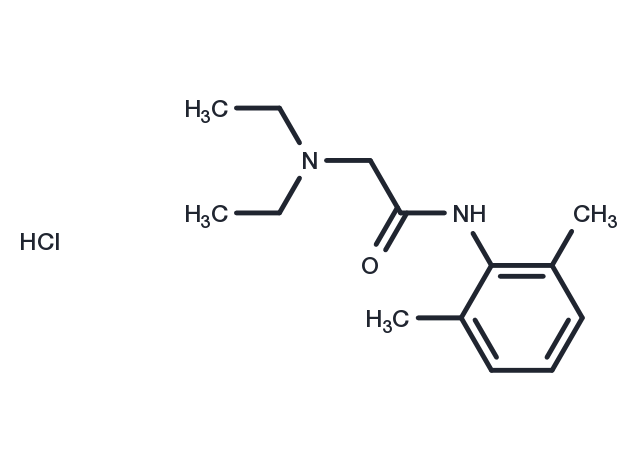Powder: -20°C for 3 years | In solvent: -80°C for 1 year


Lidocaine hydrochloride (Lignocaine hydrochloride) is a local anesthetic and cardiac depressant used as an antiarrhythmic agent. Its actions are more intense and its effects more prolonged than those of PROCAINE but its duration of action is shorter than that of BUPIVACAINE or PRILOCAINE.

| Pack Size | Availability | Price/USD | Quantity |
|---|---|---|---|
| 500 mg | In stock | $ 45.00 |





| Description | Lidocaine hydrochloride (Lignocaine hydrochloride) is a local anesthetic and cardiac depressant used as an antiarrhythmic agent. Its actions are more intense and its effects more prolonged than those of PROCAINE but its duration of action is shorter than that of BUPIVACAINE or PRILOCAINE. |
| In vitro | Lidocaine above 1.25 g/l reduces cellular viability and triggers apoptosis in HCE cells in a time- and dose-dependent manner. Lidocaine-induced apoptosis is caspase dependent and may be related to mitochondrial pathway[1]. Lidocaine, at the level of tissue concentration under topical or local administration, also has a direct inhibitory effect on the activity of epidermal growth factor receptor (EGFR), which is a potential target for antiproliferation in cancer cells[3]. |
| In vivo | Intravenous administration of the local anaesthetic lidocaine has been used to treat neuropathic pain for several decades and significantly improves postoperative pain associated with complex spine surgery and cholecystectomy. It is well established that lidocaine used for regional anaesthesia blocks impulses in peripheral nerves by inhibiting voltage-gated sodium (Na+) channels. Intravenous lidocaine has an analgesic effect on mechanical noxious response, decreases the spinal noxious response induced by peripheral pinch stimuli and the frequency of spontaneous excitatory postsynaptic currents(EPSCs) without changing their amplitude. It has no effect on spontaneous inhibitory postsynaptic currents and produces an outward current in SG neurons[2]. |
| Cell Research | Cells at logarithmic phase are treated with lidocaine hydrochloride at concentrations (w/v) from 10 to 0.15625 g/l in step dilutions. HCE cells without lidocaine treatment are used as controls. The morphology and growing status of the cells are monitored every 4 hr.(Only for Reference) |
| Synonyms | Lidocaine HCL, Lignocaine hydrochloride, Xyloneural, Lidothesin |
| Molecular Weight | 270.798 |
| Formula | C14H23ClN2O |
| CAS No. | 73-78-9 |
Powder: -20°C for 3 years | In solvent: -80°C for 1 year
DMSO: 49 mg/mL(180.9 mM)
Ethanol: 54 mg/mL (199.41 mM)
You can also refer to dose conversion for different animals. More
bottom
Please see Inhibitor Handling Instructions for more frequently ask questions. Topics include: how to prepare stock solutions, how to store products, and cautions on cell-based assays & animal experiments, etc.
Lidocaine hydrochloride 73-78-9 Apoptosis MAPK Membrane transporter/Ion channel NF-Κb NF-κB MEK ERK Sodium Channel Extracellular signal regulated kinases Lidocaine Mitogen-activated protein kinase kinase Nuclear factor-kappaB Lidocaine HCL inhibit Na channels Na+ channels Lignocaine Hydrochloride MAPKK Lignocaine Nuclear factor-κB Lignocaine hydrochloride Inhibitor MAP2K Xyloneural Lidothesin Lidocaine Hydrochloride inhibitor
